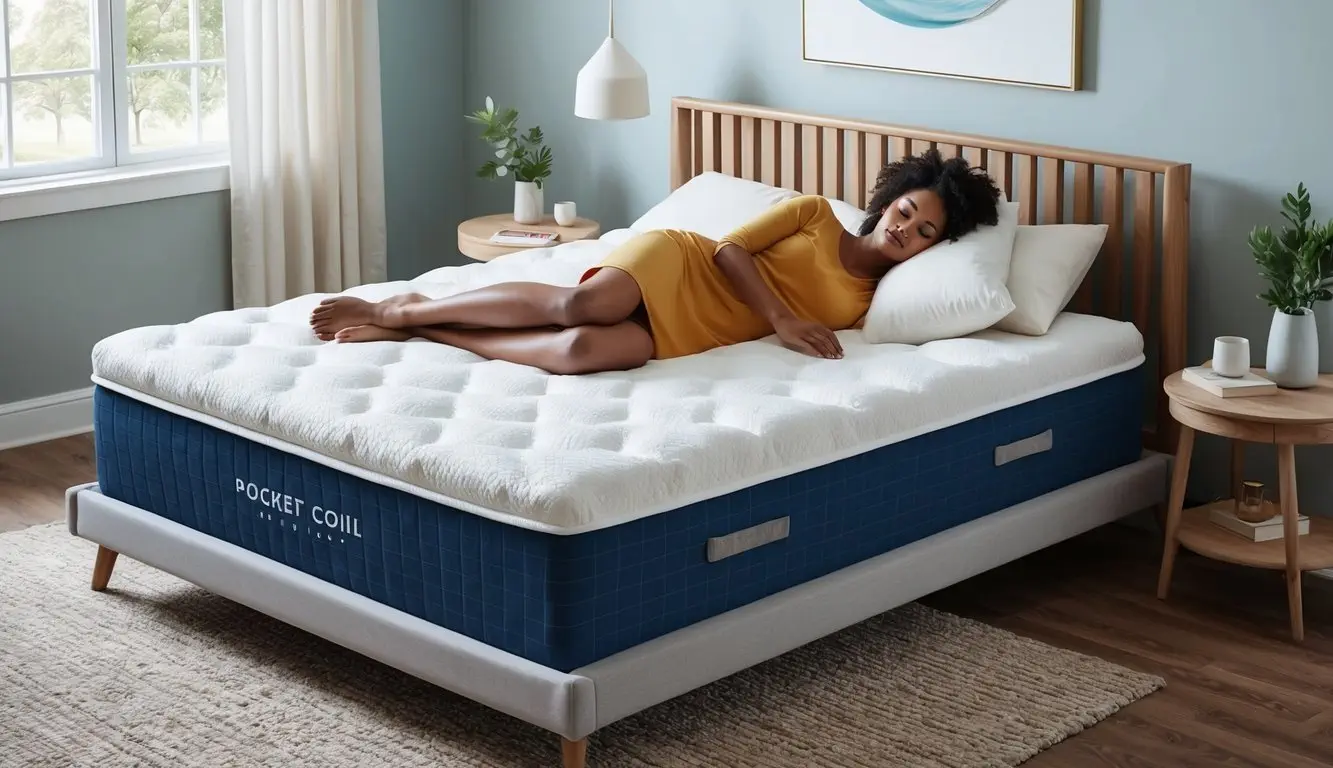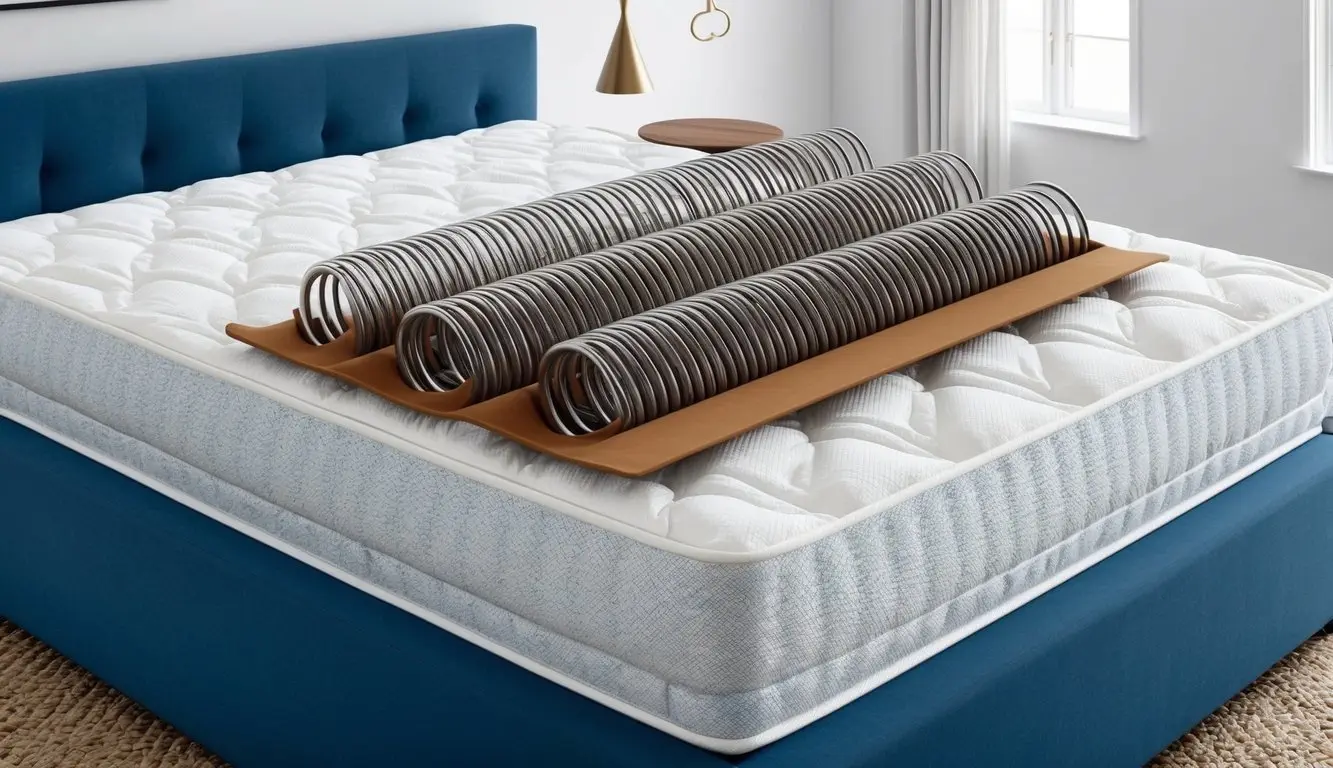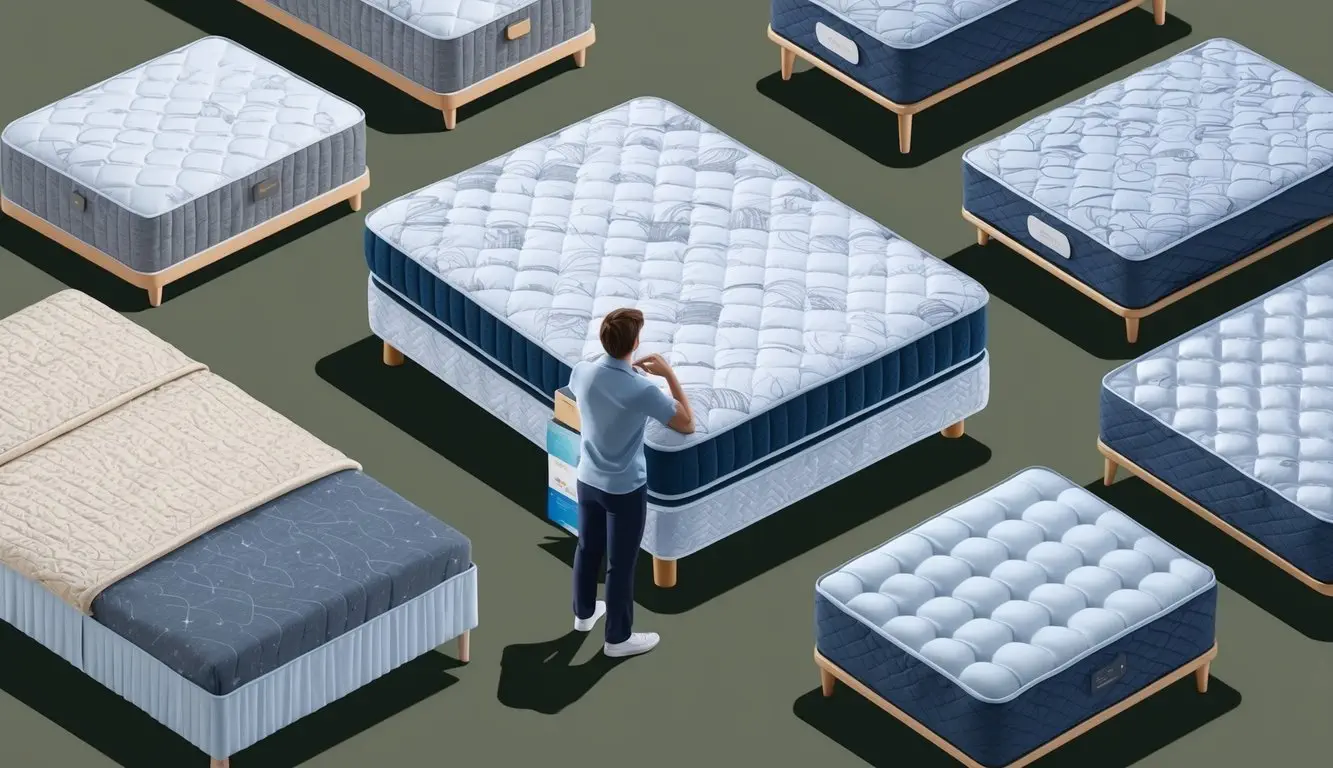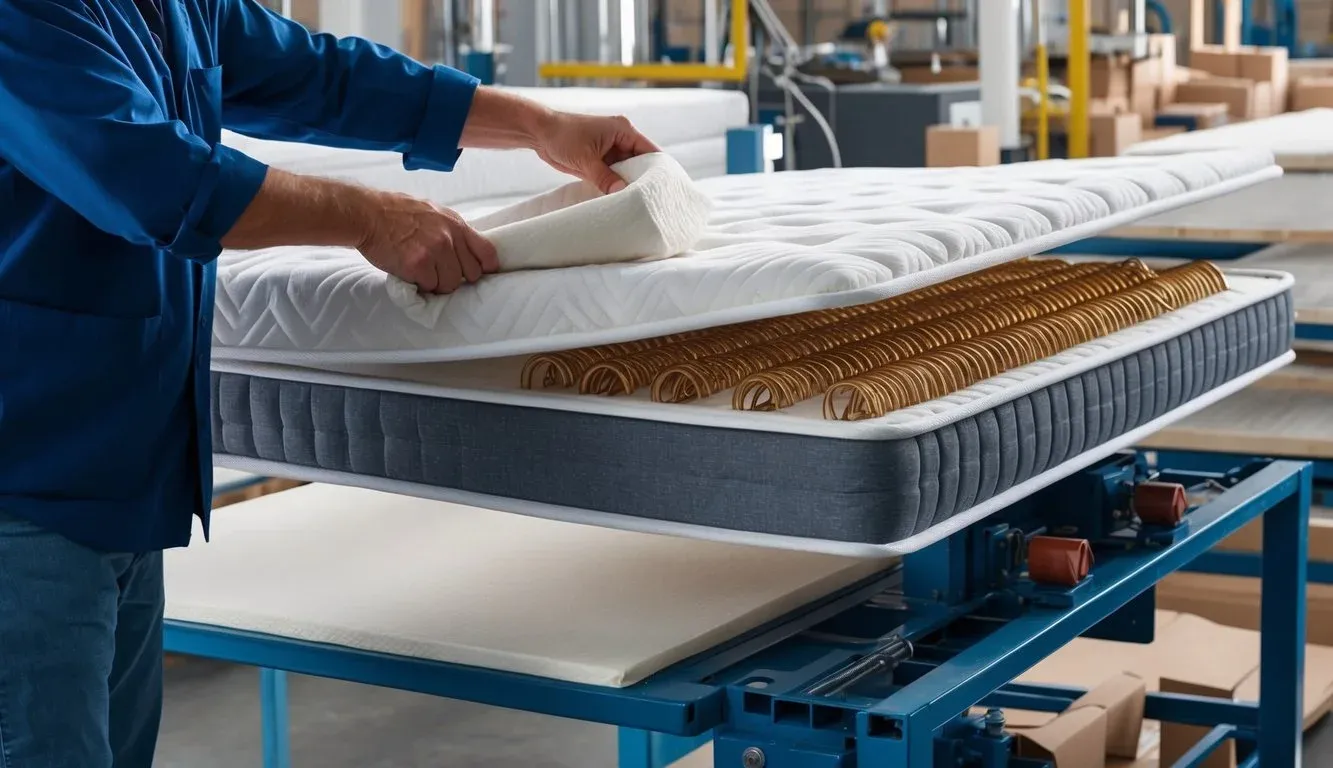Many people shopping for a new bed wonder if pocket coil mattresses are worth the cost. Pocket coil mattresses can offer better support and less motion transfer compared to traditional spring mattresses. This can mean a more comfortable sleep, especially for those who share a bed.

It’s common to see pocket coil mattresses in stores, but what really sets them apart? They have individual springs wrapped in fabric, which helps each part of the mattress move on its own. This design can help the mattress fit the body more closely than other types.
Not everyone needs the same kind of mattress, so choosing the right one can be confusing. Learning about pocket coil mattresses can help shoppers decide if the benefits match their needs. Are pocket coil mattresses worth it? Read on to find out.
What Is a Pocket Coil Mattress?

A pocket coil mattress is a type of innerspring mattress that uses individual springs wrapped in fabric. Pocketed coils are different from traditional spring mattresses because each spring works on its own, not connected to others by wire.
How Pocket Coils Work
Pocket coils are metal springs, each placed inside its own fabric pocket. These pockets keep the coils separate, so they move independently. When a person lies down, only the coils under the weight compress, while the others stay in place.
This design reduces motion transfer. For example, if someone moves or gets up on one side of the bed, the other side will not shake as much. It can help couples sleep better without feeling every movement.
Pocketed coils also allow for better contouring. The springs can adapt to the shape of the body, giving more support to areas like the shoulders and hips. This targeted support is an improvement over standard innerspring mattresses, which often have connected coils and a “bouncier” feel.
Key Features of Pocketed Coils
- Individual Support: Each coil moves alone, so they fit the body’s curves and can help align the spine.
- Motion Isolation: The separate pockets help absorb movement, making these mattresses ideal for people who share a bed.
- Breathability: Innerspring mattresses, including pocket coil versions, allow for good airflow, which helps regulate temperature.
- Durability: The fabric-encased coils are less likely to wear out quickly because each spring works independently.
Pocket coil mattresses come in various firmness levels and styles. Some use more coils for added support, while others add comfort layers like foam or latex on top for softness. This mattress type combines many benefits of traditional and modern designs.
Benefits of Pocket Coil Mattresses
Pocket coil mattresses have unique features that can help sleepers get better rest. They use individually wrapped coils to provide both personal comfort and reliable support. Many people choose them for specific reasons related to how they feel during sleep.
Targeted Support and Body Contouring
Pocket coil mattresses use coils that react individually to the body’s weight and shape. Each coil moves on its own, which means they give support exactly where it is needed most.
This design helps the mattress provide good alignment for the spine and neck. For people who sleep on their side, it helps ease pressure on the shoulders and hips. Back and stomach sleepers can also benefit from even support across their bodies.
Because the coils work separately, the mattress can contour closely to the shape of each sleeper. This allows for better pressure relief. It can also keep the body from sinking too deeply in certain spots, which can cause discomfort. The balanced support helps many people wake up with less soreness.
Motion Isolation Performance
One key benefit of pocket coil mattresses is their ability to reduce motion transfer. Since each coil is wrapped and moves independently, movements on one side of the bed do not easily travel to the other side.
This is especially helpful for couples. When one person changes position or gets up, the other sleeper is much less likely to be disturbed. Children or pets that share a bed can also move without shaking the entire surface.
Quick Comparison Table:
| Mattress Type | Motion Isolation |
|---|---|
| Pocket Coil | Very Good |
| Traditional Innerspring | Poor |
| Memory Foam | Good |
The structure of pocket coil mattresses makes them a strong choice for light sleepers sensitive to movement.
Durability and Longevity
Many pocket coil mattresses last longer than other mattress types. The coils are made of sturdy metal and are often tempered for extra strength. This helps the mattress keep its shape and support over time.
The use of separate pockets for each coil also prevents them from wearing out as quickly. There is less risk of sagging because the pressure is spread out more evenly.
Manufacturers may use reinforced edges or high-quality materials to further boost durability. With basic care such as rotating the mattress and using a proper foundation, these mattresses commonly give reliable support for years.
Sleepers who want long-term value and steady comfort often choose pocket coil designs for this reason.
Comparing Pocket Coil Mattresses With Other Mattress Types

Many shoppers want to know how pocket coil mattresses stack up against popular choices like innerspring, memory foam, and hybrid mattresses. Comfort, support, durability, and motion isolation are some of the most important factors to look at.
Pocket Coil vs. Innerspring Mattresses
Pocket coil mattresses and traditional innerspring mattresses both use metal coils, but the construction is different. In pocket coil mattresses, each coil is wrapped in fabric, so they move independently. In innerspring mattresses, the coils are usually all connected.
Key Differences:
- Motion Isolation: Pocket coil mattresses prevent movement from spreading across the bed. Innerspring beds often feel bouncier and transfer more motion.
- Support: Pocket coils adjust to the shape of the body better. Innerspring mattresses may leave gaps and give less targeted support.
- Noise: Pocket coils are quieter since coils are separated. Innerspring mattresses may squeak more when you move.
Pocket coil mattresses usually cost more, but some people find they sleep more comfortably, especially if they share the bed.
Pocket Coil vs. Memory Foam Mattresses
Memory foam mattresses use layers of foam that mold to the body under heat and weight. Pocket coils use springs wrapped in fabric to offer lift and support.
Main Points:
- Pressure Relief: Memory foam creates a “hugging” feel and reduces pressure points. Pocket coil mattresses give some contouring but also offer bounce and pushback.
- Sleeping Cool: Pocket coil mattresses usually stay cooler because air can flow between the coils. Memory foam tends to trap heat, which can feel uncomfortable for hot sleepers.
- Edge Support: Pocket coil mattresses often have stronger edges, making it easier to sit or sleep near the edge without sagging.
Some people prefer the “floating” feel of a pocket coil mattress, while others like the sinking-in sensation of memory foam.
Pocket Coil vs. Hybrid Mattresses
A hybrid mattress combines both pocket coils and foam (often memory foam or latex) in the same bed. It aims to blend the benefits of both materials.
Comparison Table:
| Feature | Pocket Coil | Hybrid |
|---|---|---|
| Coils | Yes | Yes |
| Comfort Layers | Thin | Thick Foam |
| Bounce | Medium | Medium to Low |
| Pressure Relief | Moderate | High |
| Sleeping Cool | Good | Good to Very Good |
Hybrids may offer more pressure relief and cushioning due to the added foam layers. However, this can create a softer, plusher bed, so it depends on personal preference. Both types are designed for support, durability, and cooling, but hybrids can sometimes be heavier and cost more.
Construction and Materials

The quality of a pocket coil mattress depends on its material choices and how it is built. Key details like comfort layers and the design of the coils can affect support, durability, and how the mattress feels.
Comfort Layers and Materials
The comfort layer is usually made from polyfoam, memory foam, or latex foam. Each material has specific features.
- Polyfoam is soft and inexpensive but can wear out faster.
- Memory foam adds pressure relief and hugs the body, which some people prefer for comfort.
- Latex foam is more durable and breathable, helping to keep the mattress cool during sleep.
The thickness of the comfort layers also impacts how much cushioning the mattress gives. Thicker comfort layers often make the surface softer, while thinner layers result in a firmer feel.
Most pocket coil mattresses use a mix of these materials and may have multiple layers for added comfort and support.
Coil Gauge and Coil Count
The coil gauge refers to how thick the steel wire in each spring is. Lower gauge numbers mean thicker, stronger coils (better for firm support), while higher gauge numbers make thinner, softer coils. Here’s a quick guide:
| Coil Gauge | Feel |
|---|---|
| 12-13 | Firm |
| 14-15 | Medium |
| 16+ | Plush/Soft |
Coil count is the number of coils inside the mattress. Higher coil counts usually mean better support and motion isolation, but after a certain point, extra coils don’t make a big difference. Most queen-sized pocket coil mattresses have between 800 and 1,200 coils. More coils can provide better contouring, especially for side sleepers or couples.
Types of Mattress Coils

Different mattresses use different types of coils to give support and comfort. Some coil designs are better for durability, motion isolation, or price.
Bonnell Coils
Bonnell coils are one of the oldest and most common types of innerspring coils. These coils have an hourglass shape and are made from steel wire. They are joined together with helical wires that connect each coil, so the mattress acts as one unit when someone moves.
This design can lead to more motion transfer since the coils are all connected. Bonnell coils give a bouncy, traditional feel and are often found in budget mattresses. They work well for guest rooms or for people who need a firm, basic mattress.
Pros:
- Affordable
- Easy to produce
Cons:
- Can wear out faster
- Less motion separation
They are not the best choice for long-term use if comfort and support are a top priority.
Offset Coils
Offset coils are similar to Bonnell coils in that they use an hourglass shape, but they have squared-off edges on the top and bottom. These edges are designed to join together better and flex more easily. This design makes offset coils stronger and more supportive than regular Bonnell coils.
They reduce motion transfer better because the coils can move somewhat on their own while still providing strong support. Mattresses with offset coils usually last longer and keep their shape better.
Key Features:
- Good spinal support
- Less noise when moving
- Longer lifespan than Bonnell coils
Offset coils are a solid choice for those who want sturdy support and less motion transfer, but they often cost more than Bonnell coil mattresses.
Continuous Coils
Continuous coils are made from a single piece of wire shaped into rows of coils. Unlike Bonnell and offset coils, continuous coils are not separate from each other. Instead, the wire is woven to form a connected grid.
This setup is great for keeping the mattress firm and reducing sagging since weight gets spread out more evenly. However, because the coils are closely joined, these mattresses often have more bounce and can allow more motion to travel across the bed.
Advantages:
- Durable and supportive
- Less chance of sagging
- Normally lower priced than pocket coils
Drawbacks:
- Firmer feel
- More motion transfer compared to pocket coils
Continuous coil mattresses are best for people looking for durability and support at a lower price and who don’t mind a firmer bed.
Who Should Consider a Pocket Coil Mattress?

Pocket coil mattresses provide targeted support by allowing each coil to move independently. This design can help with pressure relief, minimize motion transfer, and offer a balanced firmness.
Best Mattress Types for Side Sleepers
Side sleepers need a mattress that cushions their shoulders and hips while still supporting the waist and spine. Pocket coil mattresses with a medium firmness often suit these sleepers well. The coils respond differently to each body part, which helps prevent pressure points and promotes better alignment.
Many brands add a plush pillow top or extra comfort layers over the coils for extra softness. This helps side sleepers sink in just enough without feeling stuck. If the mattress is too firm, side sleepers may feel sore in their hips or shoulders. If it is too soft, they may not get enough support.
Look for models labeled as “medium” or “medium-soft” for the best balance of comfort level and support. Some brands also offer “zoned” coils with different firmness in areas like the shoulders and hips.
Suitability for Couples and Sensitive Sleepers
Pocket coil mattresses are a good choice for couples and people who wake up easily. Because each spring works on its own, movement on one side of the bed is less likely to be felt on the other side. This feature reduces disturbance if one partner moves or gets up at night.
Sensitive sleepers often need a comfort level that keeps their sleep stable and undisturbed. Pocket coils can absorb energy better than traditional connected coils, making them quieter and more responsive.
For couples with different firmness preferences, some brands offer dual-firmness designs. These let each person choose a feel that matches their needs. This can help both people sleep well without giving up personal comfort.
Key Considerations Before Buying

Shoppers should look at mattress height, support needs, brand differences, core features, and price points. The most suitable pocket coil mattress will depend on how these factors fit personal comfort, sleeping style, and budget.
Thickness and Firmness Preferences
Pocket coil mattresses come in many thicknesses. Thicker mattresses often have more layers, which can increase softness and pressure relief. For those who prefer a firmer surface, a thinner model or one with extra support is a better option.
Firmness varies between brands and models. Some brands, like Sealy, offer both plush and firm versions. Others, such as Serta or Beautyrest, may use extra foam or gel layers for specific comfort levels. People with back pain might prefer a medium-firm or firm option, while side sleepers could benefit from a softer top layer.
It’s important to test mattress firmness, if possible, before buying. Comfort is highly personal, so what works for one person may not suit another.
Brand and Feature Comparison
There are many pocket coil mattress brands, each with its features. Well-known brands such as Sealy, Serta, and Beautyrest have been around for years and have good reputations. Some use special materials like memory foam layers, cooling gel, or antibacterial covers.
Pocket coil designs can be different depending on the brand. For example, Beautyrest often uses “zoned” coils for targeted support, while Sealy might focus on better edge support or reinforced centers.
Buyers should check for features like motion isolation, edge support, and cooling technology. A simple checklist can help:
- Motion isolation: Good for couples
- Cooling tech: Important for hot sleepers
- Edge support: Helps keep the mattress shape and makes it easier to sit or sleep near the edge
Price and Value for Money
Pocket coil mattresses have a wide price range. Entry-level models can be found for a few hundred dollars, while luxury options may cost over $1,000. Prices depend on coil count, added comfort materials, size, and brand reputation.
It’s helpful to compare price with listed features. More expensive mattresses often have extras like natural materials, long warranties, or advanced cooling systems.
Budget shoppers should look for seasonal sales or online-only brands, which may offer better deals. Checking what’s included—like free delivery or a sleep trial—is also important. A table can help compare:
| Brand | Price Range | Key Features |
|---|---|---|
| Sealy | $400-$1,200 | Edge support, foam layers |
| Serta | $350-$1,500 | Cooling gel, motion isolation |
| Beautyrest | $600-$2,500 | Zoned coils, premium covers |
Are Pocket Coil Mattresses Worth It?

Pocket coil mattresses have a unique design that offers specific benefits for support and comfort. Many buyers want to know if these features justify the cost compared to other mattress types.
Value Proposition and Longevity
Pocket coil mattresses use individually wrapped springs. This design helps each coil move on its own while providing targeted support. The isolated movement makes them a good choice for people who share a bed, since motion transfer is reduced compared to traditional coil mattresses.
The materials and construction often lead to a longer lifespan. On average, a pocket coil mattress lasts 7–10 years before the coils or comfort layers start to wear. Higher-quality models can last longer but may come at a higher price.
For those needing back or joint support, the design can help keep the spine in alignment. However, some lower-end versions may sag faster if the coils are thin or spaced too far apart. Regular rotation may help extend the usable life.
Comparison Table
| Feature | Pocket Coil Mattress | Traditional Innerspring |
|---|---|---|
| Motion Isolation | Good | Poor |
| Lifespan (years) | 7–10 | 5–8 |
| Support Consistency | High | Moderate |
| Price Range (USD) | $400–$2,000+ | $200–$1,200 |
User Experiences and Ratings
Most users mention improved comfort, reduced partner disturbance, and reliable support as top positives. Many sleepers, especially side and back sleepers, find that the even weight distribution of pocket coils makes long nights more comfortable.
Customer reviews on popular retail sites usually average between 4.2 and 4.6 stars for mid- and high-quality models. Complaints often mention early sagging or noise if the coils are poor quality or not well padded.
People with back pain report benefits from the targeted support. However, those who prefer very soft or firm mattresses sometimes struggle to find the right level with pocket coil designs. Individual experience varies depending on brand and build quality.
Frequently Asked Questions

Pocket coil mattresses are different from other mattress types in how they support the body and respond to movement. They may help with back pain, but can also have unique issues and different lifespans compared to foam or traditional innerspring mattresses.
How do pocket coil mattresses compare to traditional innerspring mattresses?
Pocket coil mattresses use individual springs that move separately. This helps reduce motion transfer, making it less likely for one sleeper to disturb another.
Traditional innerspring mattresses use springs that are connected. These usually feel bouncier and transfer more movement from one side to the other.
What are the advantages and disadvantages of pocket spring mattresses?
Advantages include better body support and less motion transfer. Some people may find them more comfortable for sleeping with a partner.
Disadvantages can include higher prices compared to basic innerspring models. Over time, individual springs can wear out or shift, which may change the feel of the mattress.
For individuals with back pain, are pocket coil mattresses recommended?
Pocket coil mattresses can provide good support that helps keep the spine in a straight line. Many people with back pain report relief when using these mattresses.
However, not every person with back pain will benefit. The right firmness and mattress quality are important for best results.
What is the typical lifespan of a pocket coil mattress?
Pocket coil mattresses usually last about 7 to 10 years with normal use. The quality of the materials and construction will affect how long the mattress stays comfortable.
Some may last longer, but most start to lose support or comfort after several years.
Can pocket coil mattress construction lead to unique problems or issues?
Individual coils can become misaligned or lose their bounce over time. Loose coils or shifting padding may cause lumps or uneven spots in some mattresses.
Some pocket coil mattresses may make noise as they age due to the movement of individual springs.
How does a pocket coil mattress perform compared to foam mattresses?
Pocket coil mattresses offer more bounce and better air flow than foam mattresses. They are less likely to trap heat, which helps keep sleepers cool.
Foam mattresses tend to offer more contouring but can feel warmer and usually transfer less movement across the bed. Pocket coils may suit those who prefer a springier feel.